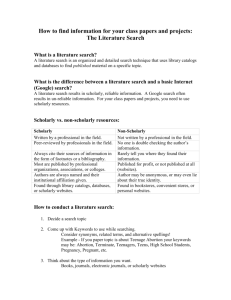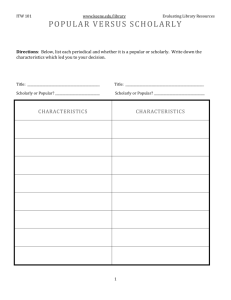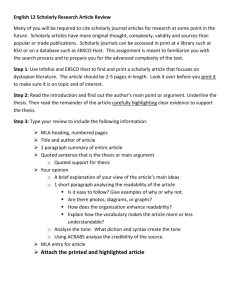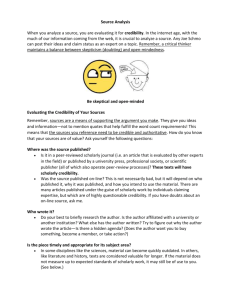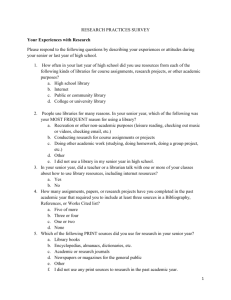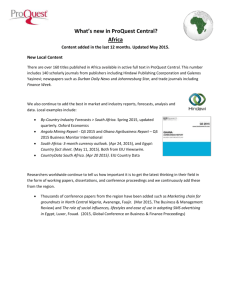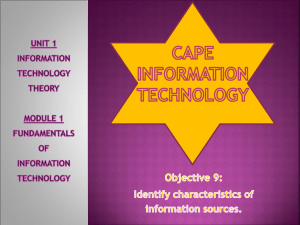Source Credibility - University of Adelaide
advertisement
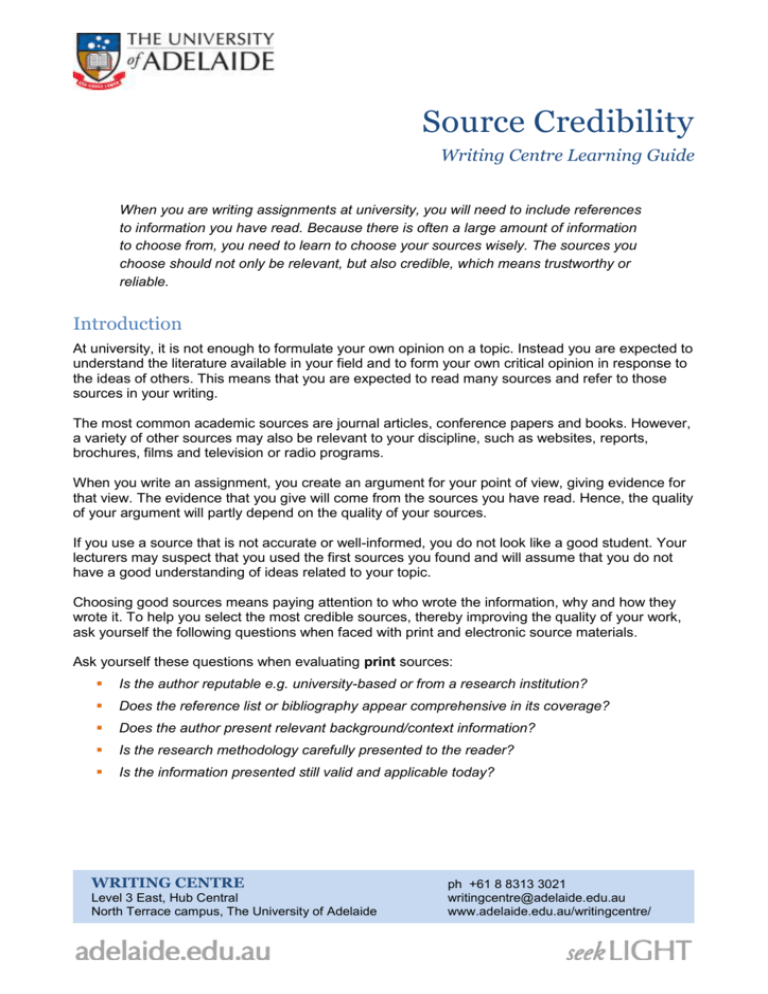
Source Credibility Writing Centre Learning Guide When you are writing assignments at university, you will need to include references to information you have read. Because there is often a large amount of information to choose from, you need to learn to choose your sources wisely. The sources you choose should not only be relevant, but also credible, which means trustworthy or reliable. Introduction At university, it is not enough to formulate your own opinion on a topic. Instead you are expected to understand the literature available in your field and to form your own critical opinion in response to the ideas of others. This means that you are expected to read many sources and refer to those sources in your writing. The most common academic sources are journal articles, conference papers and books. However, a variety of other sources may also be relevant to your discipline, such as websites, reports, brochures, films and television or radio programs. When you write an assignment, you create an argument for your point of view, giving evidence for that view. The evidence that you give will come from the sources you have read. Hence, the quality of your argument will partly depend on the quality of your sources. If you use a source that is not accurate or well-informed, you do not look like a good student. Your lecturers may suspect that you used the first sources you found and will assume that you do not have a good understanding of ideas related to your topic. Choosing good sources means paying attention to who wrote the information, why and how they wrote it. To help you select the most credible sources, thereby improving the quality of your work, ask yourself the following questions when faced with print and electronic source materials. Ask yourself these questions when evaluating print sources: Is the author reputable e.g. university-based or from a research institution? Does the reference list or bibliography appear comprehensive in its coverage? Does the author present relevant background/context information? Is the research methodology carefully presented to the reader? Is the information presented still valid and applicable today? WRITING CENTRE Level 3 East, Hub Central North Terrace campus, The University of Adelaide ph +61 8 8313 3021 writingcentre@adelaide.edu.au www.adelaide.edu.au/writingcentre/ Ask yourself these questions when evaluating electronic sources: Does your lecturer/tutor recommend the site? Who is responsible for the site? Is it associated with a respected organisation or institution? Is the organisation responsible for the site clearly identified (e.g. with an official logo) and are contact details provided? Is there obvious bias in the site? Does the source use correct grammar and spelling? Was the site recently updated? Primary vs Secondary sources Before you can begin to conduct any form of academic work, you need to consider whether it is appropriate to use: (1) primary sources or (2) secondary sources. The division between primary and secondary sources is not always apparent, but the differences discussed below are important to keep in mind as you consider the credibility of source material you use to sustain your position. Primary sources Primary sources are usually the original or ‘raw’ research, i.e. the materials that researchers have personally gathered and analysed in their work. Examples include: experiments conducted by scientists data from surveys, questionnaires, interviews, or observations original ideas expressed in sources such as government reports, speeches, or fiction (useful for topics in English, humanities and the social sciences). Primary sources in the University of Adelaide Library collection are identified in the 'subjects' heading of the online record by the word 'Sources'. To search for them directly, use the 'Advanced Search' feature on the Library website: select 'Books' for the Material Type and include the word 'SOURCES' in the 'in subject' box. For example, you might type 'Indonesia History Sources'. Secondary sources Secondary sources are when someone writes about another person’s ideas (much like you do in your assignments). In life generally, it is usually better to check what someone thinks by talking to them directly rather than relying on what someone else tells you about it. The same is true with academic sources. If you use a secondary source, you may not know whether the second writer clearly understands or has accurately retold the ideas of someone else. 2 However, in undergraduate study it can be acceptable to use some types of secondary sources. Examples include: textbooks in your discipline area articles or experiments in scientific journals that report the results of other researchers magazine or newspaper accounts of interviews, surveys or questionnaires conducted by other researchers articles or reviews in books or journals about novels, speeches or government documents. Scholarly vs Non-Scholarly sources For academic study, it is important to consider who would be the intended readers of a source. Broadly, sources can be divided into (1) scholarly or academic sources and (2) non-scholarly or popular sources. Scholarly sources When university academics write about their research and ideas for other academics to read, we call their writing a scholarly or academic source. Often this type of writing is published in scholarly journals which are peer reviewed (i.e. read and approved for publication by other scholars). Many databases of electronic sources allow you to limit your search to peer-reviewed or scholarly journals. For example, Academic Search Premier allows you to tick a box for ‘Scholarly (Peer Reviewed) Journals.’ Your lecturers may also use or tell you the names of respected scholarly journals in your field or you can check if any are listed on the library resource guide for your discipline. Other ways to identify scholarly sources: they are not usually published as often as daily or weekly magazines or popular sources they use discipline-specific rather than everyday language they do not usually include commercial advertisements or excessively flashy graphics they are written by people who are experts in their area/s they include specifically detailed information that is interesting to specialists in their area/s they acknowledge sources in sufficient detail for you to check the information or read more they use an academic style of referencing (e.g. a footnote, endnote or author-date style). Non-scholarly sources When somebody writes some interesting ideas about a topic for anybody who might be interested to read, and do not necessarily base those ideas on research, we call their writing a non-scholarly or popular source. Usually this type of writing is published in magazines or periodicals that exist to make a profit. Some examples of popular sources are Time, The Economist and National Geographic. Ways to identify non-scholarly sources: they are often not written by experts they are usually published weekly or monthly they usually give broader rather than more detailed information they are written in a language style that anybody could understand they look visually exciting with lots of colour and pictures they usually include advertisements they often do not include any references, or include only a few references in an informal style. 3 The Internet It is especially important to carefully consider web-based sources before using them in academic assignments. There will be many websites that could be relevant for any topic you may have to write about at university. However, it is not always easy to determine whether the information they contain is trustworthy. In general, it is best not to trust information you find on the World Wide Web until you can determine who wrote it. Consider the following internet ‘domain names’. Government .gov Commercial Education .edu Organisation Academic .ac Network .com .org .net The domains .gov, .edu and .ac can only be registered by government and educational institutions. For this reason, they reflect a higher order of authority than .com, .org or .net sites. Wikipedia Wikipedia has a wide range of information that can be useful to read when you are first trying to understand a topic. Wiki pages sometimes also have references or links to further information that could be useful for your assignments. However, Wikipedia was designed to be a collaborative and constantly developing encyclopedia. Any person can write a new wiki page and any person can edit or change any existing wiki page. Because of this, information from Wikipedia is not considered acceptable in academic assignments. However, if you take the time to read the sources listed in the references section of a Wikipedia page, these sources themselves may be acceptable if you reference them directly. Useful resources General http://www.brad.ac.uk/developme/developingskills/literature_reviews/index13.php http://www.library.cornell.edu/olinuris/ref/research/skill26.htm http://www.uncp.edu/home/canada/work/markport/best/evaluate.htm Internet credibility http://mason.gmu.edu/~montecin/web-eval-sites.htm http://owl.english.purdue.edu/owl/resource/588/02/ http://owl.english.purdue.edu/owl/resource/553/01/ http://www.lib.berkeley.edu/TeachingLib/Guides/Internet/Evaluate.html © The University of Adelaide 2014 4
